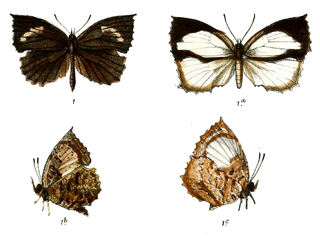
Allotinus drumila, the crenulate darkie, is a small butterfly found in India, Burma, Thailand, Laos, Vietnam, and Yunnan (China) that belongs to the lycaenids or blues family.
Cyclotorna diplocentra is a moth of the family Cyclotornidae. It is found in Australia, including New South Wales and Queensland.
Eublemma lozostropha is a species of moth of the family Erebidae first described by Alfred Jefferis Turner in 1902. It is found from Kalbarri in Western Australia north around northern Australia, through central Australia and down the eastern coast to southern New South Wales.
Eublemma rufipuncta is a moth of the family Noctuidae first described by Alfred Jefferis Turner in 1902. It is found in Australia.
Brenthia pleiadopa is a species of moth of the family Choreutidae first described by Edward Meyrick in 1921. It is found in Magude, Mozambique.
Machimia miltosparsa is a moth in the family Depressariidae. It was described by Alfred Jefferis Turner in 1914. It is found in Australia, where it has been recorded from New South Wales.
Brachynemata restricta is a moth in the family Oecophoridae. It was described by Edward Meyrick in 1920. It is found in Australia, where it has been recorded from Queensland.
Hypatima toreuta is a moth in the family Gelechiidae. It was described by Alfred Jefferis Turner in 1919. It is found in Australia, where it has been recorded from Queensland.
Ardozyga euryarga is a species of moth in the family Gelechiidae. It was described by Alfred Jefferis Turner in 1919. It is found in Australia, where it has been recorded from southern Queensland.
Ardozyga furcifera is a species of moth in the family Gelechiidae. It was described by Alfred Jefferis Turner in 1919. It is found in Australia, where it has been recorded from Victoria.
Thiotricha acronipha is a moth of the family Gelechiidae. It was described by Alfred Jefferis Turner in 1919. It is found in Australia, where it has been recorded from Queensland.
Stenoma relata is a moth of the family Depressariidae. It is found in French Guiana, Brazil (Amazonas) and Peru.
Antaeotricha incrassata is a moth of the family Depressariidae. It is found in French Guiana.

Lichenaula onychotypa is a moth in the family Xyloryctidae. It was described by Alfred Jefferis Turner in 1939. It is found in Australia, where it has been recorded from the Australian Capital Territory, New South Wales, South Australia, Tasmania, Victoria and Western Australia.
Plectophila thiophanes is a moth in the family Xyloryctidae. It was described by Alfred Jefferis Turner in 1917. It is found in Australia, where it has been recorded from Queensland.
Octasphales eubrocha is a moth in the family Depressariidae. It was described by Alfred Jefferis Turner in 1917. It is found in Australia, where it has been recorded from Queensland.
Antaeotricha demotica is a moth in the family Depressariidae. It was described by Lord Walsingham in 1912. It is found in Mexico (Guerrero) and Guatemala.
Tirathaba cissinobaphes is a species of moth of the family Pyralidae. It was described by Alfred Jefferis Turner in 1906. It is found in Australia, where it has been recorded from Queensland.
Tanycnema is a monotypic moth genus of the family Tineodidae or false plume moths. It was described by Alfred Jefferis Turner in 1922. Turner described the genus in Proceedings of the Royal Society of Victoria, writing:
Gen. Tanycnema, nov.
Frons with a strong anterior tuft of hairs. Tongue present. Palpi rather long, porrect. Maxillary palpi obsolete. Antennae short. Legs long, slender; outer tibial spurs about 3/4 length of inner spurs. Forewings narrow, elongate; 2 from well before angle, 3 from angle, 4 and 5 somewhat approximate at origin, 6 from upper angle, 7, 8, 9, 10 stalked, 7 arising slightly before 10, 11 free. Hindwings twice as broad as forewings; 2 from 3/4, 3 from angle, 4 and 5 somewhat approximate at origin, 6 well separated at origin from 5, still more widely from 7, 7 from upper angle, closely approximated to 12 for some distance, but not anastomosing.
A peculiar, isolated, and primitive genus. The wide separation of 6 from 7 of the hindwings, and the absence of any anastomosis of 7 with 12 are primitive characters; on the other hand the relative approximation of 5 to 4 in the hindwings, and the stalking of 7 and 10 of the forewings are specialised characters, the former being unique in this family, to which the genus must, I think, be referred, though the absence of maxillary palpi, suggests some relationship to the Pterophoridae, but this may be more apparent than real.

Ichneutica panda is a species of moth in the family Noctuidae. It is endemic to New Zealand and only found in central and southern parts of the South Island. The species has not been collected in Canterbury since the late 1950s and has not been seen at The Wilderness scientific reserve since 1941. This species is similar in appearance to Ichneutica falsidica however I. panda lack or have indistinct black dashes on their edge of their hindwings. I. panda inhabit shrubland from alpine zones down to river terraces and adults are on the wing between December and February. The life history of this species is unknown as is the host species of the larvae.


